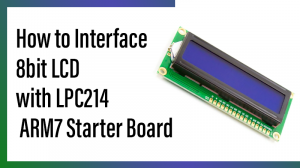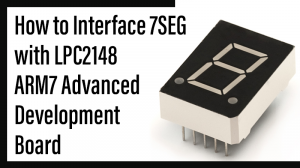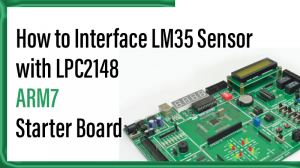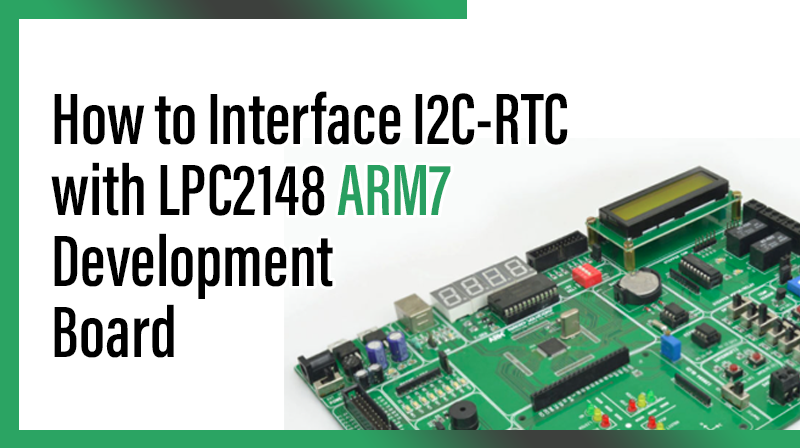
How to Interface I2C-RTC with LPC2148 ARM7 Development Board
The ARM7 LPC2148 Development Board is specifically designed to help students to master the required skills in the area of embedded systems. The kit is designed in such way that all the possible features of the microcontroller will be easily used by the students. The kit supports in system programming (ISP) which is done through serial port.
NXP’s ARM7 (LPC2148), ARM Development Kit is proposed to smooth the progress of developing and debugging of various designs encompassing of High speed 32-bit Microcontrollers.
I2C (Inter Integrated Circuit)
The I2C (Inter-IC) bus is a bi-directional two-wire serial bus that provides a communication link between integrated circuits (ICs).I2C is a synchronous protocol that allows a master device to initiate communication with a slave device. Data is exchanged between these devices.
RTC (Real Time Clock)
The DS1307 Serial Real-Time Clock is a low-power; full binary-coded decimal (BCD) clock/calendar plus 56 bytes of NV SRAM. Address and data are transferred serially via a 2-wire, bi-directional bus. The clock/calendar provides seconds, minutes, hours, day, date, month, and year information. The end of the month date is automatically adjusted for months with fewer than 31 days, including corrections for leap year. The clock operates in either the 24-hour or 12-hour format with AM/PM indicator.
Interfacing I2C – RTC
Fig. 1 shows how to interface the RTC with microcontroller through I2C. I2C is a Master-Slave protocol. I2C has a clock pulse along with the data. The master device controls the clock line, SCL. This line dictates the timing of all transfers on the I2C bus. No data will be transferred unless the clock is manipulated.
I2c bus supports many devices, each device is recognized by a unique address—whether it’s a micro-controller, LCD Driver, memory or keyboard interface and can operate as transmitter or receiver based on the functioning of the device. The controller designed controls the RTC ds1307 device through I2C protocol. The I2C Controller here acts as a master device and controls RTC ds1307 which acts as a slave. The read operation is accomplished by sending a set of control signals including the address and/or data bits. The control signals must be accompanied with proper clock signals.
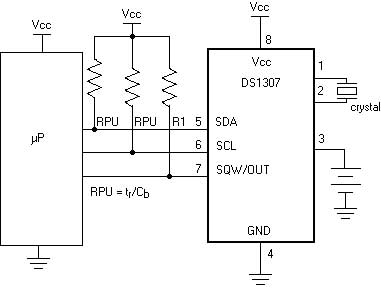
Interfacing I2C – RTC with LPC2148
Read date & time by using I2C – RTC in LPC2148 Development Board. Wiring up an I2C based RTC to the I2C port is relatively simple. The RTC also makes the software easier as it takes care of all calendar functions; accounting for leap years etc. The DS1307 (RTC) Real Time Clock IC (an I2C real time clock) is an 8 pin device using an I2C interface.
In LPC2148 Development Kit 2 nos. of RTC lines are controlled by I2C Enabled drivers. I2C Lines serial clock SCL (P0.2), serial data SDA (P0.3) connected to the I2C based serial RTC ds1307 IC. The date & times are read in LPC2148 Development Kit by using these SDA & SCL I2C lines.
Pin Assignment with LPC2148
Circuit Diagram to Interface I2C–RTC with LPC2148
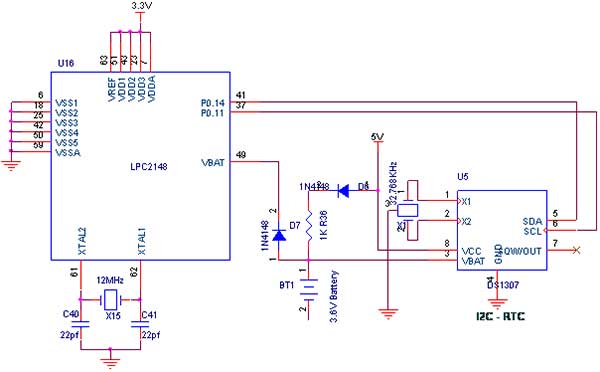
Source Code
The Interfacing I2C – RTC with LPC2148 program is very simple and straight forward that read date & time in RTC by using I2C & the value is displayed in serial port. A delay is occurring in every single data read from RTC. The delay depends on compiler how it optimizes the loops as soon as you make changes in the options the delay changes.
C Program to interface I2C – RTC with LPC2148
*********************************************************************************************
Title : Program to read date & time of I2C – RTC
**********************************************************************************************
#include
#include
#include
#include
#include
#include "UART.h"
//<<<<<<<<<<<<<<<<<<<<<<<<<<<<<<<<<<<<<<<<<<<<>>>>>>>>>>>>>>>>>>>>>>>>>>>>>>>>>>>>>>>>>>>>>>>>>>
/************************************ Macros *******************************************/
#define MAX 8
#define AA 2
#define SI 3
#define STO 4
#define STA 5
#define I2EN 6
#define ESC 0x1B
#define SW3 1<>>>>>>>>>>>>>>>>>>>>>>>>>>>>>>>>>>>>>>>>>>>>>>>>>
/*<<<<<<<<<<<<<<<<<<<<<<<<<<<<<<<<<<< Declarations >>>>>>>>>>>>>>>>>>>>>>>>>>>>>>>>>>>>>>>>*/
//<<<<<<<<<<<<<<<<<<<<<<<<<<<<<<<<<<<<<<<<<<<<>>>>>>>>>>>>>>>>>>>>>>>>>>>>>>>>>>>>>>>>>>>>>>>>>>
void I2C_ISR(void)__irq;
void UART0_ISR (void)__irq;
void Wait (unsigned int);
void I2C_Init (void);
int I2C_Start (void);
int I2C_Write (unsigned char *Buff, unsigned int Count);
char Buff[MAX] = {0x59/*CH + 10Sec + Sec*/,0x58/*Minutes*/,0x65/*0+ 12/24 + AM/PM + 10Hr + Hr*/,
0x04/*Wednesday*/, 0x04 /*Date*/, 0x11 /*Month-June*/, 0x09 /*Year*/
};
unsigned char Day[7][10]= {"Sunday", "Monday", "Tuesday", "Wednesday", "Thursday", "Friday", "Saturday"};
unsigned char Rec[MAX] = {"NO-DATA"};
unsigned char index = 0;
unsigned char flag = 0, Ready=0;
int ii=0;
char Key;
//<<<<<<<<<<<<<<<<<<<<<<<<<<<<<<<<<<<<<<<<<<<<>>>>>>>>>>>>>>>>>>>>>>>>>>>>>>>>>>>>>>>>>>>>>>>>>>
//<<<<<<<<<<<<<<<<<<<<<<<<<<<<<<<<<<<<<<<<<<<<>>>>>>>>>>>>>>>>>>>>>>>>>>>>>>>>>>>>>>>>>>>>>>>>>>
void Delay(void)
{
unsigned int i,j;
for(i=0;i<150;i++)
for(j=0;j<900;j++);
}
void Wait (unsigned int Delay)
{
while(Delay--);
}
void I2C_Init (void)
{
I2C1SCLH = 150; //50%duty cycle ..... I2C Frequency ->100 KHz for PCLK = 30MHz
I2C1SCLL = 150;
I2C1CONSET = 1 << I2EN; //Enable I2C 0
}
int I2C_Start (void)
{
I2C1CONCLR = 1 << STO;
I2C1CONSET = 1 << AA;
I2C1CONSET = 1 << STA;
return 0;
}
int I2C_Write (unsigned char *Buff, unsigned int Count)
{
while(Count--)
{
I2C1DAT = *Buff++;
}
return 0;
}
void RTC_Setup(char *Buff)
{
unsigned char TimE;
char i=0;
for(i=0;i<2;i++)
{
while(!isdigit(Key)); //Wait till Key = 0 to 9
if (i==0)
{
TimE = Key - '0';
TimE <<= 4;
}
if (i==1)
{
TimE |= Key - '0';
}
//putchar(Key);
Key = 0;
}
*Buff = TimE; //Load Setup New Value
}
unsigned char BCD2HEX (unsigned char BCD)
{
unsigned char HEX;
HEX = (BCD >> 4)*10 | (BCD & 0x0F);
return HEX;
}
//------------------------------
// Serial Port Initialize
//------------------------------
void serial_init(void)
{
PINSEL0 |= 0x00000005; /* Enable RxD0 and TxD0 */
U0LCR = 0x83; /* 8 bits, no Parity, 1 Stop bit */
U0DLL = 195; /* 9600 Baud Rate @ 12MHz VPB Clock */
U0LCR = 0x03; /* DLAB = 0 */
}
//<<<<<<<<<<<<<<<<<<<<<<<<<<<<<<<<<<< Main Function >>>>>>>>>>>>>>>>>>>>>>>>>>>>>>>>>>>>>>>>>>
int main()
{
unsigned char i, AP;
VPBDIV = 0x02;
PINSEL0 = 0x00000005; // P0.3 - SDA0 and P0.2 - SCL0
PINSEL0 |= 0x30C00000;
IODIR1 = 0x00 << SW3;
serial_init ();
U0IER = 3;
VICIntSelect = 0<<6; //UART0 ('0' - irq '1'-fiq)
VICVectCntl6 = 0x020 | 6; //VIC slot enabled
VICVectAddr6 = (unsigned long)UART0_ISR;//pass address of UART0
VICIntEnable = 1 << 6; //Enable UART0 Interrupt
VICIntSelect = 0<<19;
VICVectCntl0 = 0x020 | 19 ;
VICVectAddr0 = (unsigned long)I2C_ISR;
VICIntEnable = 1<<19;
/* Before the master transmitter mode
can be entered, the I2CONSET register must be initialized
*/
printf("HI");
I2C_Init();
UART0_PutS ("\n\r********* ARM Tyro LPC2148 I2C RTC Demo **********\n\n\r");
UART0_PutS ("\r-------------------------------------------\n");
UART0_PutS("\n\rVersion Release v1.0 25/05/09\n");
UART0_PutS("\rResearch & Development Divison\n");
UART0_PutS("\r(c) Pantech Solutions Pvt Ltd.,\nwww.pantechsolutions.net\n");
UART0_PutS("\rChennai - India\n");
UART0_PutS ("\n\r___________________________________________________\n\n\r");
UART0_PutS (">> Connect I2C Add-On Card to J11 on ARM Tyro Board .. \n\n\r");
UART0_PutS (">> Turn SCL0 and SDA0 ON by selecting SW1 on I2C ADD-ON card..\n\r");
UART0_PutS (">> Turn Power ON for RTC by selecting SW2 on I2C ADD-ON Card..\n\r");
//UART0_PutS ("> Turn SW3 ON and Check Hyperteminal to Set Time...\n\r");
UART0_PutS ("\n\r___________________________________________________\n\n\r");
Wait (5000);
flag = 'W';
I2C_Start ();
for (i=0;i<30;i++) Wait(10000);
I2C1CONCLR = 1 << SI;
printf ("\n\n\rTime");
printf ("\n\r------\n\n\r");
Delay();
while (1)
{
Wait (5000);Wait (5000);
for (i=0;i<250;i++) Wait(10000);
if (Ready == 'T')
{
AP = (Rec[3] & 0x40)?'P':'A';
ii = 1;
Delay();
printf ("%02x : %02x : %02x %cM | ",(Rec[3] & 0x1F), Rec[2], Rec[1], AP );
Delay();Delay();
printf ("%s, %02x / %02x / %02x \r", Day[Rec[4]-1], Rec[5], Rec[6], Rec[7]);
Delay();Delay();
Ready = 'F';
}
}
}
void I2C_ISR(void) __irq
{
if (I2C1CONSET & 0x08)
{
switch (I2C1STAT)
{
case (0x08) :/*... A START condition has been Transmitted...*/
if (flag == 'W')
{
I2C1CONCLR = 1 << STO;
I2C1CONCLR = 1 << STA; //Clear START Bit
I2C1CONSET = 1 << AA;
I2C1DAT = 0xD0; //Slave Addr + W 1010 p2 p1 p0 w
I2C1CONCLR = 1 << SI;
// U0THR = 'S';
}
else if (flag == 'R')
{
I2C1DAT = 0xD0; //Slave Addr + R 1010 p2 p1 p0 r
I2C1CONSET = 1 << STA;
I2C1CONCLR = 1 << SI;
// U0THR = 's';
}
index = 0;
break;
case (0x10) : /*...A repeated START condition has been Transmitted...*/
I2C1CONCLR = 1 << STA;
if (flag == 'W')
{
I2C1DAT = 0xD0; //Slave Addr + W 1010 p2 p1 p0 w
// U0THR = 'Q';
}
else if (flag == 'R')
{
//I2C1CONCLR = 1 << STA;
I2C1DAT = 0xD1; //Slave Addr + R 1010 p2 p1 p0 r
I2C1CONCLR = 1 << STO;
I2C1CONSET = 1 << AA;
I2C1CONCLR = 1 << SI;
index = 0;
// U0THR = 'q';
}
break;
case (0x18) : /*....SLA+W has been transmitted; ACK has been received....*/
if (flag == 'W')
{
I2C1DAT = 0x00;
index=0;
I2C1CONCLR = 1 << STA; //Clear START Bit
I2C1CONCLR = 1 << STO; //Clear all flags (STA, STO, SI)
// U0THR = 'D';
}
else
{
I2C1DAT = 0x00;
index = 0;
I2C1CONCLR = 1 << STA; //Clear START Bit
I2C1CONCLR = 1 << STO; //Clear all flags (STA, STO, SI)
I2C1CONSET = 1 << AA;
// U0THR = 'd';
}
I2C1CONCLR = 1 << SI;
break;
case (0x20) : /*...SLA+W has been transmitted; NOT ACK has been received....*/
if (flag == 'W')
{
I2C1DAT &= 0x7F;
index=0;
I2C1CONCLR = 1 << STA; //Clear START Bit
I2C1CONCLR = 1 << STO; //Clear all flags (STA, STO, SI)
// U0THR = 'E';
}
else
{
I2C1DAT = 0xD1;
index = 0;
I2C1CONCLR = 1 << STA; //Clear START Bit
I2C1CONCLR = 1 << STO; //Clear all flags (STA, STO, SI)
I2C1CONSET = 1 << AA;
// U0THR = 'e';
}
I2C1CONCLR = 1 << SI;
break;
case (0x28) : /*...Data byte in I2DAT has been transmitted; ACK has been received....*/
if (index < MAX && flag == 'W') // Place all the contents of Buff[] in I2C1DAT
{
I2C1DAT = Buff[index];
I2C1CONCLR = 0x20; //Clear START Bit
I2C1CONCLR = 0x38; //Clear all flags (STA, STO, SI)
index++;
// U0THR = 'F';
// U0THR = 'W';
}
else if (flag == 'R') //Generate a Repeated Start to jump to MST/REC Mode
{
I2C1CONCLR = 1 << STO;
I2C1CONSET = 1 << STA;
I2C1CONCLR = 1 << SI;
// U0THR = 'J';
}
else //Stop Transmission to EEPROM.... Data Count Reset..
{
index = 0;
flag = 'R';
I2C1CONSET = 1 << STO; //Send STOP Bit
I2C1CONCLR = 1 << AA;
//printf ("\n\r Data Successfully Written on Memory!\n");
I2C1CONSET = 1 << STA;
I2C1CONCLR = 1 << SI;
// U0THR = 'P';
}
break;
case (0x30) : /*... Data byte in I2DAT has been transmitted; NOT ACK has been received ...*/
if (index < MAX && flag == 'W') // Place all the contents of Buff[] in I2C1DAT
{
I2C1DAT = Buff[index];
I2C1CONCLR = 0x20; //Clear START Bit
I2C1CONCLR = 0x38; //Clear all flags (STA, STO, SI)
index++;
// U0THR = 'G';
// U0THR = 'W';
}
else if (flag == 'R') //Generate a Repeated Start to jump to MST/REC Mode
{
I2C1CONCLR = 1 << STO;
I2C1CONSET = 1 << STA;
I2C1CONCLR = 1 << SI;
// U0THR = 'j';
}
else //Stop Transmission to EEPROM.... Data Count Reset..
{
index = 0;
flag = 'R';
I2C1CONSET = 1 << STO; //Send STOP Bit
I2C1CONCLR = 1 << AA;
//printf ("\n\r Data Successfully Written on Memory!\n");
I2C1CONSET = 1 << STA;
I2C1CONCLR = 1 << SI;
// U0THR = 'p';
}
break;
case (0x38) : /*... Arbitration lost in SLA+R/W or Data bytes ....*/
I2C1CONSET = 0x20;
break;
case (0x40) : /*... SLA+R has been transmitted; ACK has been received.*/
//index = 0;
if (index < MAX)
{
Rec [index] = I2C1DAT;
index++;
I2C1CONSET = 1 << AA;
I2C1CONCLR = 1 << STA;
I2C1CONCLR = 1 << STO;
}
else
{
index = 0;
I2C1CONCLR = 1 << AA;
I2C1CONSET = 1 << STO;
I2C1CONCLR = 1 << STA;
}
// U0THR = 'y';
I2C1CONCLR = 1 << SI;
break;
case (0x48) : /*...SLA+R has been transmitted; NOT ACK has been received ...*/
if (index < MAX)
{
Rec [index] = I2C1DAT;
index++;
I2C1CONSET = 1 << AA;
I2C1CONCLR = 1 << STA;
I2C1CONCLR = 1 << STO;
}
else
{
index = 0;
I2C1CONCLR = 1 << AA;
I2C1CONSET = 1 << STO;
I2C1CONCLR = 1 << STA;
}
I2C1CONCLR = 1 << SI;
// U0THR = 'z';
break;
case (0x50) : /*... Data byte has been received; ACK has been returned ....*/
I2C1CONSET = 1 << AA;
if (index < MAX)
{
Rec [index] = I2C1DAT;
I2C1CONSET = 1 << AA;
I2C1CONCLR = 1 << STA;
I2C1CONCLR = 1 << STO;
index++;
// U0THR = 'x';
}
else
{
I2C1CONCLR = 1 << STO;
I2C1CONCLR = 1 << AA;
//I2C1CONSET = 1 << STA;
I2C1CONCLR = 1 << SI;
index = 0;
Ready = 'T'; //Make Ready TRUE after Reading is over!
// U0THR = 'X';
}
break;
case (0x58) : /*... Data byte has been received; NOT ACK has been returned ....*/
I2C1CONSET = 1 << STO;
I2C1CONSET = 1 << STA;
I2C1CONSET = 1 << AA;
I2C1CONCLR = 1 << SI;
flag = 'R';
index = 0;
Ready = 'T'; //Make Ready TRUE after Reading is over!
//printf ("\n\rReading Done!!\n\r");
break;
}
}
I2C1CONCLR = 1 << SI;
VICVectAddr = 0x00;
}
void UART0_ISR (void)__irq
{
char Msg;
if(((Msg = U0IIR) & 0x01) == 0) //Check Flag Status of Recieve Interrupt
{
switch (Msg & 0x0E) //Filter Msg
{
case 0x04: while (!(U0LSR & 0x20)); //Recieve Data
Key = U0RBR;
case 0x02: break; //THRE Interrupt
default : break;
}
}
VICVectAddr = 6;
}
To compile the above C code you need the KEIL software. They must be properly set up and a project with correct settings must be created in order to compile the code. To compile the above code, the C file must be added to the project.
In Keil, you want to develop or debug the project without any hardware setup. You must compile the code for generating HEX file. In debugging Mode, you want to check the port output without LPC2148 Development Board.
The Flash Magic software is used to download the hex file into your microcontroller IC LPC2148 through UART0.
Testing the I2C – RTC with LPC2148
Give +3.3V power supply to LPC2148 Development Board; the RTC Battery device is connected with the LPC2148 Development Board. First check the entire Battery device fixed properly. A serial cable is connected between the microcontroller and PC. In PC, open the Hyper Terminal for displaying the values from RTC.
Give +3.3V power supply to LPC2148 Development Board; the RTC Battery device is connected with the LPC2148 Development Board. First check the entire Battery device fixed properly. A serial cable is connected between the microcontroller and PC. In PC, open the Hyper Terminal for displaying the values from RTC.
The Hyper Terminal is working but it is not reading any value from LPC2148 Development Board, then you just check the jumper connections. Change the Battery & ds1307 device.
If any data is not coming in Hyper Terminal, then you just check the serial cable is working or not. Otherwise you just check the code with debugging mode in Keil. If you want to see more details about debugging just see the videos in below link.
☞ How to Create & Debug a Project in Keil.
☞How to interface RTC in LPC2148 Development Board.
General Information
☞For proper working use the components of exact values as shown in Circuit file. Wherever possible use new components.
☞Solder everything in a clean way. A major problem arises due to improper soldering, solder jumps and loose joints. Use the exact value crystal shown in schematic.
☞More instructions are available in following articles,

